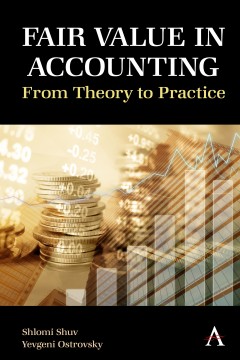Fair Value in Accounting
From Theory to Practice
By Shlomi Shuv & Yevgeni Ostrovsky
Other Formats Available:
- About This Book
- Reviews
- Author Information
- Series
- Table of Contents
- Links
- Podcasts
About This Book
Fair Value Accounting: From Theory to Practice is a comprehensive guide to fair value measurement – one of the foundations of modern-day accounting. Fair value measurement is extremely important since it touches upon both accounting and finance. Many items in the financial statements are measured at fair value, e.g. financial instruments, items acquired in business combinations and, under IFRS, investment property. In addition, fair value is used extensively as a valuation base by corporate finance and valuation specialists. The book gradually unfolds the full theoretical framework for measuring fair value for accounting purposes, while providing clear, hands-on implementation guidelines. It includes concise and informative explanations, focusing on the theoretical and practical issues arising from the relevant accounting standards and using illustrative examples and further analysis.
The book covers fair value in accordance with the two most prevalent accounting systems used worldwide: International Financial Reporting Standards (IFRS) and US Generally Accepted Accounting Principles (US GAAP). Although they take very similar approaches to the topic, there are some slight, albeit significant, differences between them that are thoroughly discussed in the book.
The book combines professional accounting literature, standards and practice into a single well-rounded and user-friendly resource. The book is intended as an essential tool not only for professionals involved in preparing or auditing financial statements – such as accountants and financial managers – but also for practitioners in related domains, such as appraisers and preparers of valuations for legal proceedings based on fair value. The book includes many practical examples for students (specifically, accounting students as well as individuals preparing to take the CPA exams) and accounting and finance researchers as well as for other academic purposes.
Reviews
This book is a reader-friendly presentation of the details of professional standards (i.e., FASB’s Accounting Codification Standard 820 and IFRS 13: Fair Value Measurement) and the practical issues in Fair Value Measurement and Disclosure, including the differences between GAAP Standards and IFRS Standards. - Choice
Author Information
Shlomi Shuv is the owner of IFRS Consulting Ltd. and Head of the Accounting Program and Vice Dean of the Arison School of Business at the Interdisciplinary Center Herzliya.
Yevgeni Ostrovsky is Senior Deputy to the Commissioner of the Capital Markets, Insurance and Savings Authority in Israel, and Head of the Accounting Division.
Series
Table of Contents
Preface; Chapter 1: Background; 1. Overview; 2. Use of Fair Value in IFRSs Compared to US GAAP; 3. Key Principles; 4. Differences between IFRS 13 and ASC Topic 820; Chapter 2: Definition and Scope of Fair Value; 1. Definition of Fair Value and the Fair Value Measurement Approach; 2. Items within the Scope of the Standards; Chapter 3: Identifying the Asset or Liability to Be Measured;1. Overview; 2. Characteristics of an Asset or Liability versus Characteristics of the Entity Holding the Asset; 3. The Unit of Account of the Asset or Liability; Chapter 4 Determining the Market in Which the Transaction Will Take Place; Chapter 5 Identifying Market Participants; Chapter 6 Defining the Transaction Price; 1. Exit Price; 2. Transaction Costs; 3. Transfer Tax and Other Transaction Costs Relating to Investment Property (IFRS Only); 4. Transport Costs; Chapter 7 Definition of an Orderly Transaction; 1. Guiding Principle; 2. Identifying Transactions That Are Not Orderly; 3. Measuring Fair Value When the Volume or Level of Trading Activity for an Asset or a Liability Has Significantly Decreased; Chapter 8 Fair Value at Initial Recognition; 1. Does the Transaction Price Represent the Fair Value?; 2. The Manner of Recognizing the Difference between Fair Value and Cost at Initial Recognition; Chapter 9 Application to Nonfinancial Assets; 1. Overview; 2. The Highest and Best Use Premise; 3. Valuation Premise for Nonfinancial Assets; Chapter 10: Measuring Fair Value of Liabilities and Equity Instruments; 1. Guiding Principle; 2. “Transfer” versus “Settlement”; 3. Liabilities and Equity Instruments Held by Other Parties as Assets; 4. The Measured Item Is Not Held by Other Parties as Assets; 5. Non- Performance Risk; 6. Restriction on the Transfer of a Liability or Equity Instrument; 7. Financial Liability with a Demand Feature (IFRS Only); Chapter 11: Application to Financial Instruments with Netting Positions; 1. Overview; 2. Relevant Definitions; 3. Scope of the Exception; 4. Qualifying Off setting in Respect of Market Risk Exposure; 5. Qualifying Off setting in Respect of the Credit Risk of the Reporting Entity and the Counterparty; 6. The Relationship between the Measurement of the Fair Value of a Net Position and Its Presentation in the Statement of Financial Position; 7. Allocation of the Portfolio-Level Adjustments to Individual Instruments; Chapter 12 Valuation Techniques; 1. Overview; 2. Considerations in Selecting a Valuation Technique; 3. Principal Approaches of Valuation Techniques; 4. Using Multiple Valuation Techniques; 5. Calibration of Valuation Techniques; 6. Changing the Valuation Techniques; 7. Adjusting Inputs Used in the Valuation or Adjusting the Valuation Techniques Themselves; 8. Selecting the Inputs Used in the Valuation Technique and the Fair Value Hierarchy; Chapter 13: Disclosure Provisions; 1. Overview; 2. The Scope of the Disclosure Requirements; 3. The Objective of the Disclosure; 4. Recurring and Nonrecurring Fair Value Measurements; 5. Determining Appropriate Classes of Assets and Liabilities; 6. Summary of Disclosure Requirements; 7. Disclosure Requirements for Assets and Liabilities Measured at Fair Value; 8. The Meaning of the Term “End of the Reporting Period”; 9. Policy Regarding Transfers between Levels within the Fair Value Hierarchy; 10. Disclosure Provisions That Apply to Fair Value Used Only for the Notes to the Financial Statements; 11. Other Required Disclosures; 12. Disclosure Examples; 13. Disclosures for Investments Subject to the NAV Practical Expedient (US GAAP Only)
Links
Stay Updated
Information
Latest Tweets



